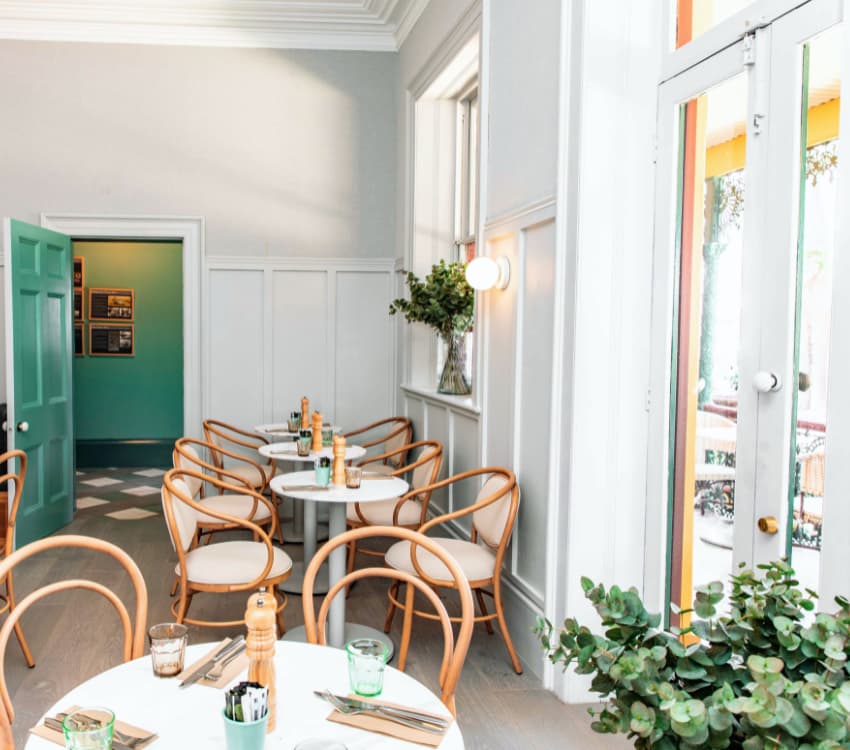Choosing the right restaurant seating and furniture is as important as crafting a great menu. How your furniture is arranged, the materials used, and the overall comfort level can significantly impact customer experience, dining duration, and return visits.
Whether launching a fine dining establishment, a casual café, or a fast-paced eatery, getting the seating right ensures your space is inviting, functional, and reflective of your brand.

Your Restaurant’s Needs
Before selecting furniture, it’s important to consider:
- Dining style: Are you catering to fast-moving customers or encouraging longer stays?
- Customer expectations: Do your guests prefer a relaxed setting or a formal dining experience?
- Aesthetic & branding: How does the furniture reflect the overall ambience of your restaurant?
These factors influence seating choices, layout design, and furniture materials to create the best dining environment.
Choosing the Right Seating for Your Venue
Dining Chairs & Tables
Standard in most restaurants, available in wood, metal, plastic, or upholstered finishes.
- Round tables work well for intimate dining and conversation.
- Square tables maximise seating flexibility and can be rearranged.
- Rectangular tables are best for large groups and banquet-style seating.
Banquette Seating (Fixed Booths)
- Popular in casual dining, pubs, and fine dining venues.
- Provides privacy, comfort, and space efficiency.
- Available in leather, vinyl, or fabric upholstery.
Bar Stools & High Tables
- Ideal for bars, bistros, and casual dining areas.
- Available in fixed or swivel styles, with or without backrests.
- The height should align with the bar counter for easy accessibility.
Outdoor Seating (Weatherproof Options)
- Suitable for patios, rooftop dining, and beer gardens.
- Common materials include synthetic rattan, aluminium, treated wood, and waterproof plastic.
- Stackable chairs provide easy storage during winter months.
Functional & Comfortable Layout
Spacing Between Tables
- Fine dining requires 70–80cm of space between tables for a relaxed atmosphere.
- Fast-casual restaurants may seat tables closer together to maximise occupancy.
- Always maintain clear walkways for servers and customers.
Customer Flow
- High-traffic areas such as entrances, waiting areas, and restrooms should be strategically placed to avoid bottlenecks.
- A logical layout ensures smooth service and a comfortable environment.
Using Dividers for Privacy & Noise Reduction
- High-backed booths, screens, or shelving help separate seating areas.
- Essential for family-friendly restaurants and open-plan spaces.
Furniture Materials
Wooden Furniture
- It is classic, versatile, and often used in pubs and mid-range dining establishments.
- Available in solid oak, beech, walnut, or reclaimed wood.
- Requires periodic treatment with wood oil or varnish.
Metal & Industrial-Style Seating
- Ideal for modern and urban restaurants.
- Sturdy and easy to clean but may require cushions for comfort.
Upholstered Seating
- It is found in luxury dining and lounge areas.
- Fabrics include leather, faux leather, velvet, or commercial-grade textiles.
- Must meet BS 7176 Fire Retardant Standards for commercial use.
Plastic & Resin Furniture
- Common in casual dining and outdoor settings.
- Lightweight, weather-resistant, and easy to maintain.
Accessibility & Safety
Fire Safety
- All upholstered seating must meet BS 7176 Fire Retardant Standards.
- Use medium-hazard upholstery for restaurants and high-hazard for high-risk venues.
Wheelchair Accessibility
- UK law requires accessible dining areas under the Equality Act 2010.
- Tables should allow space for wheelchair users to dine comfortably.
Stable & Secure Seating
- Chairs should be sturdy and designed for commercial use.
- Avoid lightweight furniture that may tip over easily.
Bar & Lounge Seating
- Bars should have comfortable stools with footrests and back support.
- Lounge areas benefit from soft seating, coffee tables, and warm lighting.
- Consider multiple seating options to cater to casual drinkers and long-stay guests.
Aesthetic Appeal & Brand Identity
- Select furniture that complements your restaurant’s decor.
- Use a mix of textures and colour schemes to create a cohesive look.
- Consider wood, metal, and fabric finishes that align with your theme.
Maintenance Tips for Restaurant Furniture
- Regularly wipe down tables and chairs to prevent stains.
- Use scratch-resistant coatings on wooden surfaces.
- Clean upholstery weekly to remove dust and spills.
- Store outdoor furniture under covers during colder months.
BE Furniture Sales
We understand the importance of quality commercial furniture for restaurants at BE Furniture Sales.
We offer fast delivery across the UK, competitive pricing, and exceptional customer service. Whether setting up a new restaurant or refurbishing an existing space, explore our cafe furniture range today to find the perfect furniture for your business.
Related Articles
- Commercial Restaurant & Cafe Furniture Design Guide
- Maintenance Tips for Restaurant & Cafe Furniture
- Restaurant and Café Design Trends for 2025
- Colour in Restaurant Design
- Time to Rethink Your Restaurant Furniture